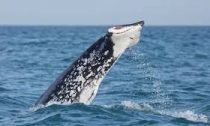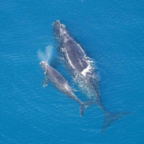
Alisa Schulman-Janiger was observing gray whales off Mexico in 1985 when, instead of a majestic fluke rising from the water, she saw an ugly stump.
It was a whale without a tail. “My jaw literally dropped,” she recalls.
Since then, there have been occasional sightings of tailless whales in western North America. But so far this year, at least three flukeless gray whales have been spotted migrating northward along California’s coast—a spike that has Schulman-Janiger concerned for their well-being.
There are no signs these animals have suffered a killer whale attack, or a collision with a ship, she says; instead, the injuries are likely due to entanglement in fishing gear.
When the marine mammals feed in areas with lots of fishing gear, debris, and other human-made objects, ropes and nets can get stuck at the base of their tail, gradually sawing off the fluke or cutting off blood circulation until it withers away. (Read how industrial fishing takes up half the planet’s oceans.)
And the prognosis for these entangled whales is not good: “The majority of them—if not all of them—are going to most likely die from these injuries,” says Justin Viezbecke, California stranding network coordinator for the National Oceanic and Atmospheric Administration.
Without flukes, feeding is difficult: Gray whales need their tails as a propeller to navigate headfirst into the muddy seafloor and filter out small crustaceans.
What’s more, the species’ lengthy migration from birthing grounds in Mexico to feeding grounds in the Arctic becomes extremely challenging without a tail to power their journey. (See “A Gray Whale Breaks the Record for the Longest Mammal Migration.”) Flukeless mothers also can’t defend their calves from killer whales.
That said, Schulman-Janiger, a whale biologist who runs the American Cetacean Society’s Gray Whale Census and Behavior Project, is fascinated by some animals’ ability to adapt to their handicap.
The flukeless gray whales she knows of will twist their bodies to the right in a corkscrew-like fashion, gaining momentum to dive back down after surfacing to breathe.
She’s particularly impressed by one tailless female, which she says has been sighted several times over the years, sometimes even with a calf by her side. “We don’t know how she migrated all the way to Alaska,” she says.
It’s not clear why such sightings tend to be gray whales, considering humpbacks get entangled the most among whales in North American waters.
Pieter Folkens, a professional whale disentangler for NOAA, suspects it’s because grays are less dependent on their flukes than other species, and therefore may be able to survive longer without their tails. (See “14 Jaw-Dropping Pictures of Whales.”)
“Blues and humpbacks are lunge feeders, which requires a powerful fluke to feed,” he says in an email.
JUST A FLUKE?
The uptick in gray whale sightings is in line with a general increase in whale entanglements over the years. Between 2000 and 2012, the number of such incidents averaged 10 per year, according to NOAA. In 2017, there were 31, Folkens says.
The reason for the rise is unknown, though people might just be better at noticing them, says Folkens.
But there are also more whales around to become entangled. Populations of grays, blues, and humpback whales have flourished in recent years, he says. (Watch “Gray Whale Swims With Beachgoers in Incredible Aerial Video.”)
Some entangled whales can be rescued—trained wildlife experts freed six of those 31 reported cases in 2017 on the U.S. West Coast, Folkens says—and a few break free on their own.
But finding a long-term solution is a challenge. Scientists don’t know exactly how whales get entangled, or even where, as these affected animals can travel large distances before being discovered. (Read about a fisherman who died moments after rescuing an entangled whale.)
Some fisheries are working on ways to prevent whale entanglement, such as the California dungeness crab fishery, which traps the crustaceans via seafloor cages suspended on long lines. The gear contributed to a record number of entanglements in 2016.
Viezbicke hopes for some better outcomes soon for the large marine mammals. Getting caught in fishing nets, he says, “limits their ability to be a whale.”














Social Profiles